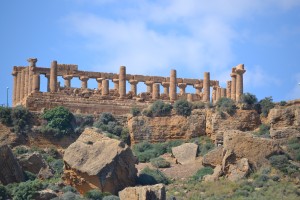 I encountered a similarly positive experience with another cooperative the following morning. Established in 1969, Viticultori Associati Canicattì, alternately referred to as CVA or simply Canicatti, is now home to 480 vinerons and 1,000 hectares. The vineyards are situated in the sunniest and driest part of Sicily, stretching out to the coast of Agrigento and comprising a wide range of altitudes from sea level to 600 m above the water.
I encountered a similarly positive experience with another cooperative the following morning. Established in 1969, Viticultori Associati Canicattì, alternately referred to as CVA or simply Canicatti, is now home to 480 vinerons and 1,000 hectares. The vineyards are situated in the sunniest and driest part of Sicily, stretching out to the coast of Agrigento and comprising a wide range of altitudes from sea level to 600 m above the water.
As with MandraRossa, each vine is constantly monitored so as to identify the optimal moment for harvest. The vineyards are planted to both indigenous and international varieties, including: Catarratto, Inzolia, Grillo, Nero d’Avola, Nerello Mascalese, Nerello Cappuccio, as well as Chardonnay, Cabernet Sauvignon, Syrah and Merlot.
Given the cooperative’s proximity to the Valle dei Templi (Valley of the Temples), the winery has a unique relationship with the park. Consequently, I was blessed with the opportunity to taste through their extensive portfolio just steps away from Greek and Roman ruins. Led by Technical Director, Angelo Molito, we started with a lovely, slightly sparkling wine, Satari Frizzante 2012, before we tasted through a selection of still whites. We then shifted to a Nero d’Avola-Nerello Mascalese rosato blend. Next up were the lighter-bodied reds, including the Aquilae Nero d’Avola, their most sold wine.
Finally, we turned our attention to a mini-vertical of Aynat, the winery’s flagship wine produced in very limited quantities from low yielding, 25-30 year old Nero d’Avola vines and aged in barrique and bottle before release. I was astounded by the beauty, depth, elegance and age-worthiness of this wine, particularly when tasting the 2006.
Just outside the Park Authority’s boundaries, Canicatti has recently taken possession of 3 hectares of 20-25 year old vines, situated in the shadow of the Temple of Giunone. The fruit from these vines will make their debut at VinItaly 2014 in the guise of Diodoros 2012 – Nectar of the Gods. A blend of Nero d’Avola, Nerello Cappuccio and Nerello Mascalese, the wine was first vinified in stainless steel in November 2012 and then, in May 2013, was transferred to barriques. Since the wine still has a full year of oak aging ahead, my preview tasting of a tank sample was an honor, but not a real assessment of what this wine will be upon release.
As we walked through the Diodoros vineyard, Angelo told me that the almond trees are strikingly beautiful when in bloom. I joked that I would be back in January to see them and, given the warm welcome I received that day, I’m almost convinced that if I were to show up on his door next year, he wouldn’t miss a beat before inviting me into his home and then taking me to see the trees.
Then, all too soon, it was time to head off to my final destination, Tasca d’Almerita.
